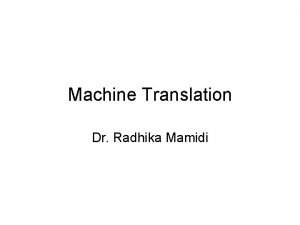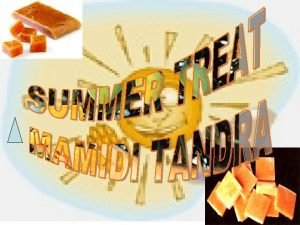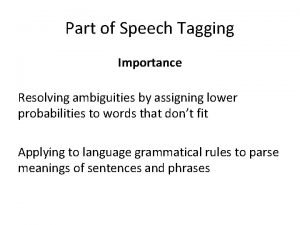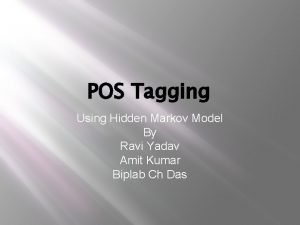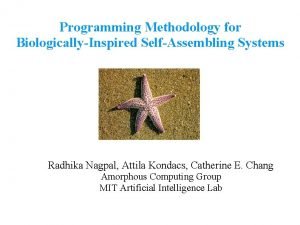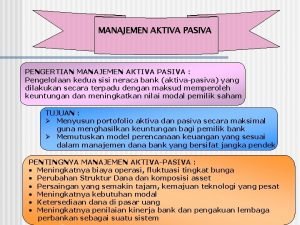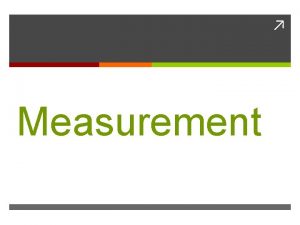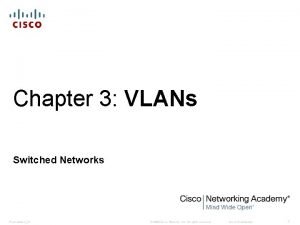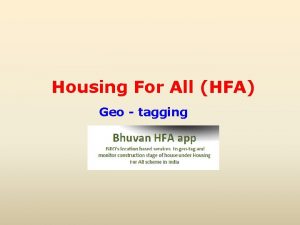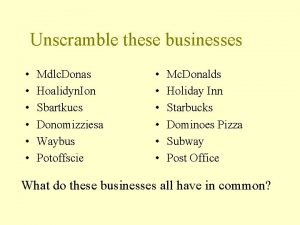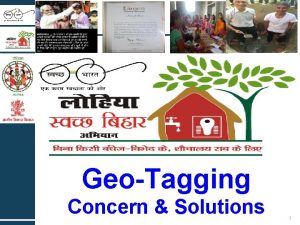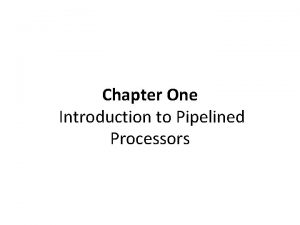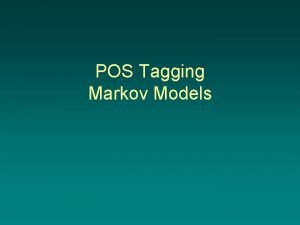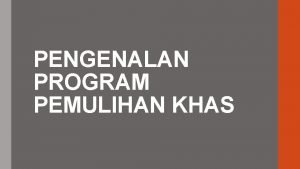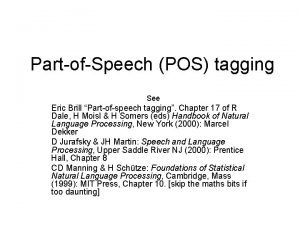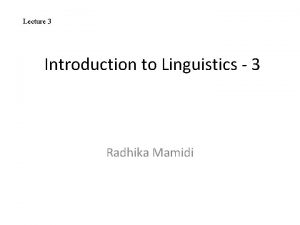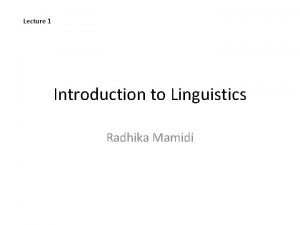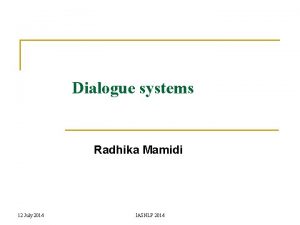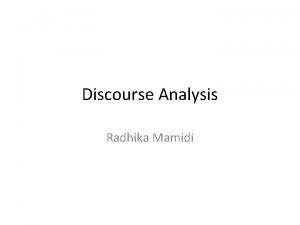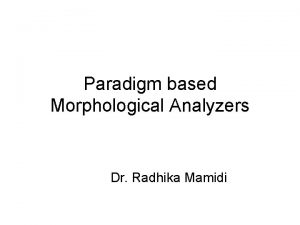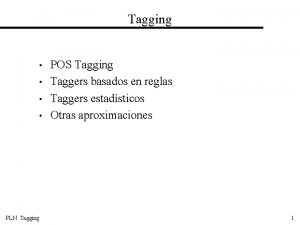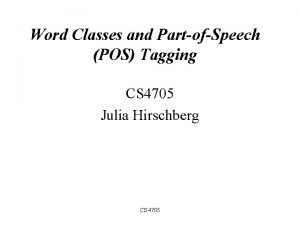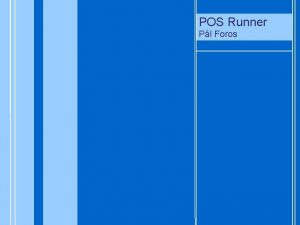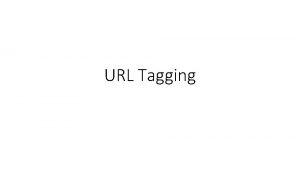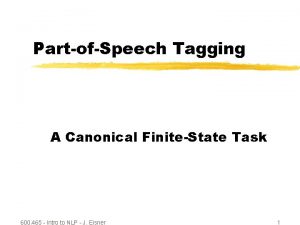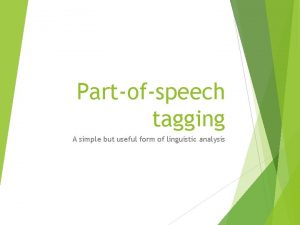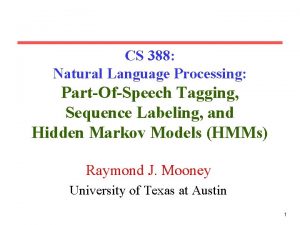PartOfSpeech Tagging Radhika Mamidi POS tagging Tagging means



![Applications • Used as preprocessor for several NLP applications [Machine Translation, HCI…] • For Applications • Used as preprocessor for several NLP applications [Machine Translation, HCI…] • For](https://slidetodoc.com/presentation_image_h2/7d42a2fac2973e1973e800b4d3d3103e/image-4.jpg)













- Slides: 17

Part-Of-Speech Tagging Radhika Mamidi

POS tagging • Tagging means automatic assignment of descriptors, or tags, to input tokens. Example: “Computational linguistics is an interdisciplinary field dealing with the statistical and logical modeling of natural language from a computational perspective. ”

Output Computational_AJ 0 linguistics_NN 1 is_VBZ an_AT 0 interdisciplinary_AJ 0 field_NN 1 dealing_VVG with_PRP the_AT 0 statistical_AJ 0 and_CJC logical_AJ 0 modeling_NN 1 of_PRF natural_AJ 0 language_NN 1 from_PRP a_AT 0 computational_AJ 0 perspective_NN 1. _. [using CLAWS pos tagger]
![Applications Used as preprocessor for several NLP applications Machine Translation HCI For Applications • Used as preprocessor for several NLP applications [Machine Translation, HCI…] • For](https://slidetodoc.com/presentation_image_h2/7d42a2fac2973e1973e800b4d3d3103e/image-4.jpg)
Applications • Used as preprocessor for several NLP applications [Machine Translation, HCI…] • For information technology applications [text indexing, retrieval…] • To tag large corpora which will be used as data for linguistic study [BNC, . . ] • Speech processing [pronunciation, . . ]

Approaches

Supervised taggers • Supervised taggers typically rely on pre-tagged corpora to serve as the basis for creating any tools to be used throughout the tagging process. • For example: the tagger dictionary, the word/tag frequencies, the tag sequence probabilities and/or the rule set.

Unsupervised taggers • Unsupervised models are those which do not require a pretagged corpus • They use sophisticated computational methods to automatically induce word groupings (i. e. tag sets) • Based on those automatic groupings, the probabilistic information needed by stochastic taggers is calculated or the context rules needed by rule-based systems is induced.

SUPERVISED UNSUPERVISED selection of tagset/tagged corpus induction of tagset using untagged training data creation of dictionaries using tagged corpus induction of dictionary using training data calculation of disambiguation tools. may include: induction of disambiguation tools. may include: word frequencies affix frequencies tag sequence probabilities "formulaic" expressions tagging of test data using dictionary information tagging of test data using induced dictionaries disambiguation using statistical, hybrid or rule based approaches calculation of tagger accuracy

Rule based approach • Rule based approaches use contextual information to assign tags to unknown or ambiguous words. • These rules are often known as context frame rules. • Example, If an ambiguous/unknown word X is preceded by a determiner and followed by a noun, tag it as an adjective. det - X - n = X/adj

STOCHASTIC TAGGING Any model which somehow incorporates frequency or probability, i. e. statistics, may be properly labeled stochastic.

a. Word frequency measurements • The simplest stochastic taggers disambiguate words based solely on the probability that a word occurs with a particular tag. • The problem with this approach is that while it may yield a valid tag for a given word, it can also yield inadmissible sequences of tags.

b. Tag sequence probability • The probability of a given sequence of tags occurring is calculated using the n-gram approach • It refers to the fact that the best tag for a given word is determined by the probability that it occurs with the n previous tags. • The most common algorithm for implementing an ngram approach is known as the Viterbi Algorithm. • It is a search algorithm which avoids the polynomial expansion of a breadth first search by "trimming" the search tree at each level using the best N Maximum Likelihood Estimates (where n represents the number of tags of the following word).

Hidden Markov Model • It combines the previous two approaches –i. e. it uses both tag sequence probabilities and word frequency measurements • HMM's cannot, however, be used in an automated tagging schema, since they rely critically upon the calculation of statistics on output sequences (tagstates).

Baum-Welch Algorithm • The solution to the problem of being unable to automatically train HMMs is to employ the Baum-Welch Algorithm, also known as the Forward-Backward Algorithm. • This algorithm uses word rather than tag information to iteratively construct a sequences to improve the probability of the training data.

Refer • Notes by Linda http: //www. georgetown. edu/faculty/ballc/ling 361/ tagging_overview. html • Chapter 11 The Oxford Handbook of Computational Linguistics • POS tagging demo: CLAWS (the Constituent Likelihood Automatic Wordtagging System) tagger http: //www. comp. lancs. ac. uk/ucrel/claws/trial. html

Assignment 2 Part 1: • Identify the parts of speech of each word in the following text. Machine translation (MT) is the application of computers to the task of translating texts from one natural language to another.

Part 2 • Give 5 examples of a word that belongs to more than one grammatical category. • Example: book N – I bought a book V – I booked a ticket. Part 3 • Use the online CLAWS POS tagger and submit the tagged output of a paragraph [at least 5 sentences] of your choice. • CLAWS (the Constituent Likelihood Automatic Word-tagging System) • http: //www. comp. lancs. ac. uk/ucrel/claws/trial. html
 Translate in english
Translate in english Chittibabu and chinnababu live in atreyapuram town in
Chittibabu and chinnababu live in atreyapuram town in Pos tagging
Pos tagging Unsupervised pos tagging
Unsupervised pos tagging Radhika nagpal
Radhika nagpal Pengertian manajemen aktiva dan pasiva
Pengertian manajemen aktiva dan pasiva Meta means change and morph means heat
Meta means change and morph means heat Meaning of biodiversity conservation
Meaning of biodiversity conservation Quadrilateral pentagon hexagon octagon
Quadrilateral pentagon hexagon octagon Life bio
Life bio Morphe means in metamorphism
Morphe means in metamorphism Untagged vs tagged vlan
Untagged vs tagged vlan Bhuvan hfa geotagging app
Bhuvan hfa geotagging app Donas franchise
Donas franchise Geotagging in panchayat
Geotagging in panchayat Internal forwarding and register tagging
Internal forwarding and register tagging Tagging
Tagging Tagging guru dalam eoperasi
Tagging guru dalam eoperasi
